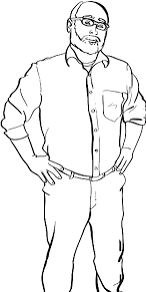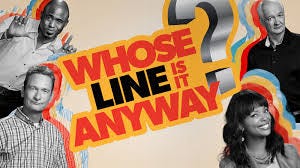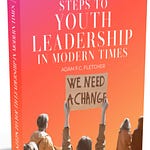Brad Fortier joined me for a Q&A about using improvisation to solve problems on and off stage, to explore truths about ourselves, and to build community in the most unlikely of places.
I first met Brad when I was a student in an improv class he was teaching. He was an engaging teacher and skilled performer who made hopping onto a stage and creating a 45-minute story with no props or lines seem effortless.
Brad is now working as an organizational trainer with a focus on equity and inclusion. He took many of the games and principles he taught me and many others and now applies them to solve problems in workshops and workplaces to disaster zones.
There’s a lot packed into this interview — failing faster, engaging others in productive play or dialogue, improv games, the art of debriefing, using improv to bridge cultural and language differences, and how Brad ended up getting fired as a Park Ranger (sort of).
Brad can be found at Bradfortier.com.
Please enjoy my conversation with Brad Fortier.
EB: Hi Brad. Thank you for joining me today.
Brad: Thank you, Eoin.
EB: Let’s start by getting your pulse on the “workplace” in air quotes because I think people are finding it more fragmented, disjointed, or isolated as many are working remotely or away from physical office spaces — not ideal for building community. Are you noticing shifts in how people interact through your work as an organizational trainer & improv teacher?
Brad: Oh, for sure. I don't think it's any big news that COVID pushed us all into camps, even more than was happening before the pandemic. I'm working from home 98% of the time. And, even though I'm connecting with my colleagues in meetings and other things digitally, it's not the same as when we get to work in each other's physical presence and have that live connection — which feels so much more vital these days.
A thing that I often notice in teaching improv is the activities we ask people to do often tune up relationship building. There’s a lot of eye contact, talking, and listening.
Eoin: Do you think people (working remotely or hybrid) need more time to get warmed up to being with each other?
Brad: Yeah. Here's an example, I got hired in July of 2021, and I had been working 5 or 6 months before I met most of my colleagues in person for the first time. So, we tended to stay online after we had done a training simply to have conversations and get to know each other better because we don’t see much of each other in an office space. So, it was something all of us naturally gravitated towards. I think people miss the liveliness of being in a shared physical space — and it's a thrill when it happens.
Eoin: Has this also affected your ability to perform improv?
Brad: Yes, this year I’m finally rehearsing for an in-person improv performance with other players and it's wonderful to have that again.
Eoin: One of the things that stood out about your background is that you were trained as an anthropologist. My basic understanding is that anthropology is the study of human culture and how cultures develop. What connections have you made between anthropology and improvisational theater?
Brad: When I was doing my undergraduate studies in anthropology, I was also doing a lot of improv work at the Brody Theater (closed in 2018), as an instructor, performer, and director. I ended up taking a medical anthropology course in my undergrad studies that opened the door to the idea that anthropologists can study any facet of human endeavors. A light went on.
Around this time, I went to Berlin and performed at the Berlin International Improv Festival. One of the show forms that's done at these international festivals is called translation. Translation is an improv game when during the first half of the game, all of us speak our native language & in the second half we speak a language we do not speak or understand.
It worked great with a European audience because most Europeans speak 3 or 4 languages. The reason I bring this up in terms of anthropology is because it was fascinating that we (the players) could still understand the tone of each other’s language and make a scene work.
I'm like, there's gotta be so much more going on under the surface for us to be able to surmount language, achieve comedy, and still connect and have an enjoyable time despite the language barriers. So, I began to see connections between what I was studying (anthropology) and what I saw play out on stage.
Eoin: Which language did you choose to speak that night?
Brad: Oh, in the first half, of course, English, but in the second half, Russian. I know the least Russian. I studied it a little bit in college, but I don't have too many words.
Eoin: When you approach an improv game like this, speaking a language you don’t know, how do you go about it? Do you have to shut down a part of your brain to allow yourself to pretend to speak Russian, especially in front of a live audience?
Brad: I don't think it's shutting off as much as engaging the rust on it. You know, it's been years since I was in a Russian class, or I studied French or German — but I'm pretty adept at French. I've studied that for a long time. But, going back to it out of the blue was very much like turning on a gear I don’t use much. So, with Russian, it was just like, I know my numbers, I know some of my greetings…So, I was just looking for opportunities to use those appropriately in a scene.
Eoin: I still have a memory of being in a scene with you when you were my instructor at the Brody Theater. I am sure you will not remember this because you have taught so many students at this point. But, in the scene, you created a horse out of nothing. And, suddenly, you and I were grooming the horse in a scene.
I have since learned a fundamental piece of improv theater is offering other players gifts to help advance a scene or build a story — this is what I think you were doing for me in the class that evening.
Brad, how would you describe the fundamentals of improv and how do you help people get started with learning it?
Brad: The first thing I try and address is people's anxiety about it. Like, if there is one commonality I've run into that is a kind of double-edged sword, it’s Whose Line is it Anyway being the introduction to improvisation for most people.
There's this immediate concept of “I have to be clever and funny” to do any sort of improvisation. And, I usually tell people, no, you have to be able to listen and tell the truth. Like, those are the vital parts of improvisation. And, secondarily, to have a sense of wonder and a generous spirit.
And, I usually tell people, no, you have to be able to listen and tell the truth. Like, those are the vital parts of improvisation.
Also, we are geared to improvise. I mean, at its simplest, improvisation is making meaning or doing our best with what's at hand. So, in any improvised scene, I have some things to share. Like, if I start depicting a horse, you know what a horse is at least — that it's a big animal that people ride.
So, establishing some of those basics in a scene is a way to kind of start to put things together for you and me to play. And, I think that's what the generosity of spirit is about — I don't put 20 animals out to you? I just put one out, because one's probably enough. And then, I wait to see how you react because that's the gift I bring, and you'll have a gift to add to it.
So, if we can kind of follow that step-by-step, it will be a lot more joyful and easier for the two of us to see what's important and emerging together.
Eoin: I was curious, do you remember the moment, if there was one, when you got hooked on improv theater?
Brad: I think it was my second or third improv class. Tom Johnson, owner-operator & artistic director of the Brody, was teaching. And, we were doing an exercise called What's in the Closet? where you mime objects that the instructor calls out (e.g., take a bowling ball out of the closet, take 10 feet of chain link out of the closet). And, your job is to depict through mime taking an object out of a closet and putting it on the table. It was doing that exercise where I was like, I'm meant for this. I'm such a weirdo. This is the kind of stuff I do anyway.
That was it. I was hooked.
I was like, you're telling me, doing voices, characters, and mime work, and that's most of it, and telling stories. Like, I'm all in.
Eoin: Are there core practices you use to warm yourself up before a performance?
Brad: A lot of it is working with the people I'm gonna be on stage with. So, warming up can be anything from clapping in a circle or a game called Zip Zap Zop to doing mirroring exercises to get into each other's heads and presence.
Eoin: When you're teaching improv, you mentioned people do have anxiety about it initially, and you try to dispel some of that. What do you do to help people take healthy and safe risks on stage or off (e.g., workplace)?
Brad: Often, we use the word resilience when working with groups. I like to talk about training in improvisation is about shortening the distance between making a mistake and getting back on our feet.
And so we present games where we can practice that.
For example, there's a new choice game where two people are in a scene and whoever's moderating the game either has something that makes a noise (e.g., bell), and they'll say “new choice!”. Then, the player has to either revise their line and offer something else OR revise their action and do something different. And that's the way to kind of start getting people doing improv with abandon — it's all disposable.
Eoin: I think you are touching on another key concept that is relevant to many workplaces.
Brad: Yes, and I would never ask a surgeon to say their actions are disposal. That's ridiculous. But, I would say when it comes to the social environment or doing things that are creative or iterative in a workspace where lives are NOT at stake, there's some essential learning that has to happen through failure. You know, design work is always that kind of iterative thing. So, improv games can help us start to experience a detachment from our choices and work to offer us more flexibility in accepting that there will be mistakes, but also seeing opportunity in those mistakes.
improv games help us start to experience a detachment from our choices & work to offer us more flexibility
Brad: Another big idea I like to put forward to people is this notion of a failure bow, and that's not my idea.
It's an idea that's been out there for a while, but it's not that you make a big deal of your failure and then you just move on. Instead, you give it a little bit of mental energy — you bow and recognize it. But now you're done with the emotional part, and better able to move on to try and achieve your goal.
So those are some of the tools that we use to get people into the headspace of “mistakes happen”. And honestly, mistakes mean you're learning. You're trying. So, reframing, I think, is very important.
training in improvisation is about shortening the distance between making a mistake and getting back on our feet
Eoin: I’m curious if you could share an example of how improv games helped a group to solve a challenging problem.
Brad: Yes, I consulted with a healthcare client, here in town. I'll let them be anonymous.
What we did, in essence, was create games that allowed them to break out and observe things in different ways. One of the games/exercises we did is something called Artist, Model & Clay, In the game, you put people together in trios and each of them has a role. They are either (a) the artist who'll be sculpting the clay, (b)the clay that will be sculpted, or (c) the model, the person who takes a pose.
The artist is asked to turn the clay into a model. But, the clay cannot see the model. Only the artist can. And, I have groups of three do it in silence. So, in advance, I have a conversation about personal safety and respecting boundaries.
For this agency, we overlayed different meanings for each role. Like, what if we made the artist —>the director of the clinic, the clay —>the staff, and the model —> the policies?
Or, what if the artist —> patient, the doctor —> clay, and the model —> our knowledge about health and healing? How can we start to work with and adjust this game from all those perspectives?
And then, it just blew up — the whole conversation allowed them to reframe a lot of the work they did within their clinics, including taking that game to other clinics and playing it with doctors and things like that.
Eoin: So, what seems like a fairly simple game can lend itself to addressing some unspoken or complex organizational issues. I am curious when you debrief activities what types of questions do you like to ask?
Brad: Yeah. There is a formal applied improvisational network that has over 5,000 professionals globally and an annual conference as well. It’s a good resource for how to debrief after activities.
But, the questions I often use for debriefing are things like:
How did that make you feel?
How did the process/activity go for you?
How did you manage any kind of challenge that you ran up against during this activity/game?
Usually, these types of questions help open up a conversation before we even get to the forced analogy thing. Because, there's the feeling and doing level of things and then there's the concept-connecting to the client's actual work.
Eoin: I think sometimes in workplaces we can get caught up with spoken or written language as the only form of communication.
Brad: Yes, in my experience, we get lost in the language sometimes, and it's hard to reach an agreement or understand what people are saying, especially, going back to the beginning of our discussion in digital workspaces that we find ourselves in more and more.
Eoin: As we draw to a close, I'd love you to share the inspiration for your recent workshops and training.
Brad: It kicked off in 2014 when I developed a program for Latin American youth who were coming over the border and being massively sheltered. I worked with a shelter down in San Antonio, Texas, where I created a process called the Spontaneous Village, which is a repeating improv curriculum that allowed the youth to essentially get to know each other and staff rapidly to form a community that they felt connected to and safe within.
I'm glad to say it was successful, but there was there were definite moments of doubt at the beginning.
I became good friends with the head of the refugee program, although she was one of the biggest skeptics at the beginning. But, became its biggest proponent afterward. She saw unexpected impacts of the workshops I facilitated and she witnessed instances where the youth were using facets of the improv games to surmount language barriers. Because not all the youth spoke Spanish, many spoke other kinds of tribal languages. They didn't have a language together. Through improv games, they started at least playing together and making connections. That was fascinating to watch.
Eoin: How did you get involved with this project?
Brad: I was invited to the workshop by a non-profit organization called the Field Innovation Team which aims to empower communities impacted by disasters or crises to cultivate resilience.
I was asked if there was an improv component I could bring to support youth coming over the US/Mexico border. I read through the anthropology literature on refugee work to see what are the essential needs and crises of refugees. And, it gave me ideas to bring into a curriculum for this situation.
48 hours later…I'd cooked up a curriculum, and all of a sudden, I was on the phone with the Field Innovation Team. By the end of the call, they asked me if I would like to try out my program in San Antonio, TX.
And weeks later, I was doing it.
It was an amazing and also heart-wrenching experience working with children in crisis. But, that's what launched me into the trajectory I'm living through today. I’ve since used applied improv to help connect humans and build stronger communities. It makes me so happy to do that.
Eoin: What type of improv activities did you think would connect with the youth refugees?
Brad: There are 4 essential parts I explored with them — familiarity, routine, trust, and then, community — in that order.
What that means curriculum-wise is starting with the real basics of improvisation where we play name games. We also played games where we said, I like X or Y thing, and everybody who liked it raised their hand. Then, the person in the middle points to a new person whose hand is up and they come in and say something else they like.
This is also a rapid way for people to learn each other's names to see who has similar likes and dislikes to you. The technical term is sociometric information. Playing games that allow a lot of that, which are low-risk, is extremely helpful in getting familiarity established out of the gate.
Priming familiarity also lays the foundation for building routines. Playing games every day is where routine comes in. You're getting names and connections established. And, it also allowed the staff of this program to participate in the same thing to build more trust and develop community with the youth.
That was one of the first big discoveries. The improv games helped the youth see the staff more like family and less like overseers. It turned out to be a vital discovery both for staff and the youth and it kind of heightened and created a more rapid road to mutual respect. From there, we scaffolded the curriculum with more advanced games to help the youth to have fun together and share stories.
Eoin: To review: familiarity, routine, trust, and community.
Brad: Yes, familiarity, routine, trust, and community. Community-building typically comes last, as the final piece.
Eoin: Last question, I promise! I've noticed that you have been helping organizations learn how to be more aware of visible or invisible power dynamics. Are you drawing on the same improv toolbox or are you developing new activities to explore issues around diversity, equity, and inclusion?
Brad: Well, that's the good thing about improvisation. It's got several different tools built in. Like, the whole notion of status was explored by Keith Johnstone, a giant in the field of improvisational theater. Status is a super useful tool to help people start to observe and understand how power moves between people, even in a single conversation.
I do an annual talk for the Rotary Youth Leadership Academy, where I specifically help young people notice power dynamics by simulating job interview scenarios. I have volunteers come up and practice some of the skills and concepts that we talk about. That’s an amazing way to get people to notice status differences.
When it comes to invisible structures of power — it's just like asking a fish, how's the water? We mostly live in our bubbles and only have our own experiences to judge the world from. That's what leads to problems a lot of times.
Simulating things together allows for conversations to happen around each other's lives and work experiences that are a lot less fraught than if we were to dive right into taboo subjects for many people — if that makes some sense.
Eoin: Yes, can you provide a quick example of how that might look?
Brad: Sure, I did this at a conference in Minneapolis. I devised a scenario where we made lists of behaviors based on a status position.
Positive high status: use power to nurture others and lift them up.
Negative high status: use power to manipulate others’ work and keep them down.
Positive/negative low status: use whatever tools we have to bolster people through our networks or to hamstring people through our networks.
There were about 8 people at each table and there was a manila envelope and colored cards that had lists of behaviors on them.
Everybody got a card or menu of how to behave in a “meeting”. The scenario was organizing a holiday party. Participants were asked to use their cards to inspire specific behaviors during a 2-minute meeting.
It was a very diverse audience. There was practically every identity you could imagine. However, they all had the same cards and the same behaviors. Once the scenario was done, we ended up having a really powerful 45-minute debrief conversation where everybody got to share their experiences through their unique lens.
That's where this scenario work has its strength. I would offer the caveat to be wary of retraumatizing people. I try and be conscious of putting lists of behaviors together that are less likely to trigger someone — yet, close enough to the truth of people's lives and experiences to enable them to have an honest conversation. And that's where it can be productive because then people can just listen and map the “table scenarios” onto their own experiences.
Eoin: Sounds like they would also have ownership over the activity because it's drawing on their material.
Brad: Exactly right.
Eoin: Thanks so much for fielding all my questions today. I appreciate all your time and insights.
Brad: You are welcome, great chatting with you Eoin.
Bonus material:
Eoin: Who is Ranger Doug?
It looks like you were part of a mockumentary about a park ranger who appeared to be working in Forest Park (a large park in Portland, OR) or some wooded area.
Was that video fully improvised and how was it made?
Brad: It was as improvised as a Christopher Guest movie would be improvised with some scripts provided. The short movie was an outcome of a 48-hour film festival. There was a team of 2 or 3 people who were the writing team. Most of the filming took place on a Saturday and you had to submit it by Sunday at 5 p.m. So it was truly 48 hours to make a film.
Links:
Upcoming classes led by Brad Fortier
If you enjoyed this post, please consider sharing it or subscribing if you would like to receive the latest updates.
Be well and stay curious,
Thanks for reading.
Eoin

























Share this post